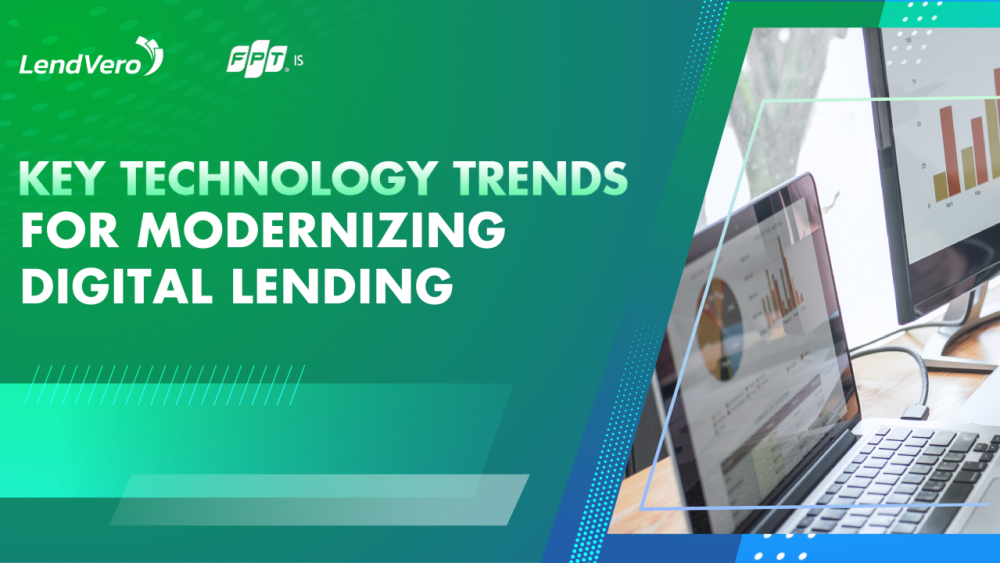Embracing The Future: Key Technology Trends For Modernizing Digital Lending
In the rapidly evolving world of technology, modernizing digital lending systems has become crucial for financial institutions. Over the years, the landscape of digital lending has transformed significantly, moving from basic solutions to sophisticated systems. This evolution highlights the increasing complexity and demand in the market
From the initial stages, where lending processes were primarily manual and paper-based, digital lending solutions have progressed to offer automated, efficient, and customer-centric services. Innovations in fintech have played a pivotal role in this transformation, providing seamless and secure lending experiences.
As customer expectations grow and competition intensifies, financial institutions must innovate and modernize their lending systems to stay relevant. Modernization enables institutions to offer faster, more personalized services, improve operational efficiency, and enhance security measures. This shift is not just a technological upgrade but a strategic move to meet the dynamic needs of the digital economy and foster long-term growth.
Key Technology Trends in Digital Lending
In the ever-evolving digital landscape, several key technology trends are transforming the digital lending industry. These advancements are not just enhancing the efficiency of financial institutions but also reshaping the overall customer experience.
Artificial Intelligence and Machine Learning
Artificial Intelligence (AI) and Machine Learning (ML) are transforming the financial sector by enhancing how institutions process and analyze customer data. These technologies enable lenders to precisely predict credit risks by using advanced algorithms to analyze historical lending data. This improved risk assessment leads to more informed decisions, faster loan approvals, and fewer errors.
AI-powered chatbots and virtual assistants are also improving customer service in the financial industry. They offer personalized guidance during the loan application process and handle routine inquiries, allowing human staff to address more complex issues and improve the customer experience.
Blockchain and Smart Contracts
Blockchain technology is bringing greater transparency and security to the financial sector, especially in lending. It uses a decentralized, tamper-proof ledger to record all transactions, eliminating the need for intermediaries and ensuring data integrity. This system fosters trust by providing a single, immutable record that cannot be altered, reducing fraud risks.
Smart contracts, which are self-executing agreements coded into the blockchain, further streamline the lending process by automating actions based on predefined terms. This automation cuts costs, speeds up loan disbursement, and increases efficiency. Together, blockchain and smart contracts create a secure and transparent lending environment, enhancing trust among all participants.

Cloud Computing
Cloud computing has revolutionized the financial industry, particularly in lending, by offering scalable and cost-effective services. It allows financial institutions to quickly adjust computing resources based on demand, avoiding the need for large investments in hardware. By outsourcing data storage and processing, lenders reduce capital and operational costs, benefiting from a pay-as-you-go model.
This technology also supports large-scale data analysis, helping institutions make better decisions, improve risk assessments, and optimize their lending portfolios. As cloud computing continues to gain traction, it enhances efficiency, flexibility, and cost-effectiveness in the lending sector, leading to better customer experiences and sustainable growth.
Big Data Analytics
Big data analytics is transforming the lending industry by enhancing customer engagement and product development. By analyzing vast amounts of customer data, financial institutions can gain deep insights into customer behavior and preferences, allowing them to offer personalized products and services. This tailored approach creates a more engaging lending experience.
Additionally, big data analytics helps lenders optimize their offerings by identifying trends and opportunities for innovation. This enables financial institutions to refine products and develop new ones, staying competitive in the market. Embracing big data analytics leads to better customer experiences, optimized products, and informed decision-making, driving sustainable growth in the lending industry.
Cybersecurity and Data Privacy
As the lending industry undergoes digital transformation, it faces increasing cybersecurity risks, including data breaches, malware, phishing, and ransomware. Financial institutions must prioritize robust security measures to protect against these threats, such as advanced threat detection, multi-factor authentication, and regular system updates. Employee training on cybersecurity best practices is also crucial.
Protecting customer data is another key concern, as lenders handle sensitive information and must comply with regulations like GDPR and CCPA. To maintain customer trust and avoid penalties, lenders invest in secure data storage, encryption, and access controls, and appoint data protection officers to oversee these efforts.
The Future of Digital Lending
As the lending industry continues to undergo a profound digital transformation, the future of the sector is poised to be shaped by rapid advancements in emerging technologies. Financial institutions are increasingly recognizing the immense potential of these cutting-edge innovations to streamline operations, enhance customer experiences, and drive sustainable growth.
Emerging Technologies
The lending industry is poised to be transformed by a wide range of emerging technologies beyond AI and blockchain.
One such technology is Robotic Process Automation (RPA), which automates repetitive, rule-based tasks in the lending process, such as loan application processing, document verification, and data entry. This can help lenders improve efficiency, reduce errors, and free up employees to focus on more complex, value-added tasks.

Natural Language Processing (NLP) is another powerful technology shaping the future of digital lending. NLP algorithms can analyze and extract insights from unstructured data, such as customer emails, call transcripts, and social media interactions. This can help lenders better understand customer needs, sentiments, and pain points, allowing them to provide more personalized and responsive service.
Computer vision technologies are also being leveraged by lenders to automate the analysis and verification of documents, such as loan applications, pay stubs, and property appraisals. This can help streamline the underwriting process and reduce the risk of human error. The Internet of Things (IoT) is another technology transforming the lending industry, as lenders can use IoT data to monitor the condition and utilization of collateral, such as vehicles or real estate, to better assess risks and make more informed lending decisions.
Looking ahead, the potential of quantum computing to revolutionize the lending industry is also being explored. Quantum computing enables faster and more accurate credit risk assessments, portfolio optimization, and fraud detection. Additionally, augmented and virtual reality technologies are being leveraged to create more engaging and personalized customer experiences, such as virtual tours of properties or augmented reality-based loan simulations.
Challenges and Opportunities
Cybersecurity Concerns
As financial institutions navigate the digital transformation of the lending industry, they face a multitude of challenges that must be addressed to unlock the full potential of emerging technologies. One of the primary challenges is the need to maintain robust cybersecurity measures to protect the sensitive financial data of both the institution and its customers. With the increasing threat of cyber-attacks and data breaches, lenders must invest in advanced security solutions and implement rigorous risk management protocols to safeguard their systems and ensure the trust of their clientele.
Regulatory Compliance Complexities
Another significant challenge lies in the complexity of regulatory compliance. The lending industry is heavily regulated, and financial institutions must navigate a constantly evolving landscape of rules and regulations, both at the national and international levels. Ensuring that their digital lending practices adhere to these regulations, while simultaneously driving innovation, can be a delicate balancing act for lenders.
Technological Integration and Talent Development
Furthermore, the integration of emerging technologies, such as AI, blockchain, and IoT, requires a substantial investment in infrastructure, talent, and training. Lenders must be prepared to allocate significant resources to upskill their workforce, modernize their IT systems, and foster a culture of innovation that can effectively harness these transformative technologies.
As the digital lending industry continues to evolve, the key for financial institutions will be to strike a balance between addressing the challenges and seizing the opportunities presented by these transformative technologies. By embracing a culture of innovation, investing in the right capabilities, and prioritizing customer-centricity, lenders can position themselves to thrive in the digital age and unlock new avenues for growth and success.
Transforming the Digital Lending Experience with LendVero
LOS (Loan Origination System)
Streamlined Loan Origination
At the heart of LendVero's offering is the seamless automation of the loan application and underwriting workflow. By harnessing the power of AI-driven algorithms, the system can swiftly and accurately assess credit risk, allowing lenders to make informed decisions with remarkable speed and precision. This not only improves the overall efficiency of the lending process but also ensures that borrowers receive a personalized and frictionless experience, aligning with the growing demand for instant gratification in the digital age.
Comprehensive Data Integration
At the heart of LendVero's offering is the seamless automation of the loan application and underwriting workflow. By harnessing the power of AI-driven algorithms, the system can swiftly and accurately assess credit risk, allowing lenders to make informed decisions with remarkable speed and precision. This not only improves the overall efficiency of the lending process but also ensures that borrowers receive a personalized and frictionless experience, aligning with the growing demand for instant gratification in the digital age.

Enhanced Transparency and Security
The integration of blockchain technology within the LendVero ecosystem further enhances transparency, security, and trust. By leveraging the decentralized and immutable nature of blockchain, lenders can establish a tamper-proof record of all loan transactions, mitigating the risk of fraud and enhancing regulatory compliance. Additionally, the integration of blockchain-based smart contracts can automate various loan lifecycle events, such as disbursements and repayments, reducing manual interventions and improving operational efficiency.
Empowered Sales and Customer Engagement
LendVero's suite of sales enablement tools, including loan simulations and mobile applications, empowers lenders to engage with their customers more effectively. By providing borrowers with personalized loan options and real-time visibility into the application process, LendVero helps financial institutions cultivate stronger customer relationships and foster a more positive lending experience.
As the financial sector continues to embrace the transformative power of technology, solutions like LendVero stand at the forefront of the digital lending revolution. By seamlessly integrating AI, blockchain, and customer-centric features, LendVero enables lenders to navigate the challenges and seize the opportunities presented by the evolving digital landscape, ultimately positioning them for long-term success and growth.
Revolutionizing Debt Collection with LendVero
Automated Collection Activities
At the core of LendVero's debt collection system is the seamless automation of collection activities, including calling, texting, and other communication touchpoints. By harnessing the power of sophisticated algorithms and machine learning, the system is able to analyze vast troves of data to classify debtors based on their unique profiles and risk levels.
Personalized Collection Strategies
This data-driven approach allows lenders to tailor their collection strategies, ensuring that each borrower is engaged with the most effective and personalized methods. This not only improves recovery rates but also reduces the burden on collection teams.
Enhanced Efficiency and Effectiveness
One of the key advantages of LendVero's debt collection system is its ability to leverage big data analytics to enhance the overall efficiency and effectiveness of the debt collection process. By drawing insights from a wide range of data sources, including payment history, demographic information, and even behavioral patterns, the system can identify the most optimal collection strategies for each debtor.
Improved Visibility and Control
The integration of powerful management and tracking tools within the LendVero ecosystem empowers lenders to monitor the progress of their debt collection efforts in real time. This level of visibility and control allows them to make data-driven decisions, adjust their strategies as needed, and ensure that no outstanding debt goes unrecovered.
Big data analytics in the debt collection process is a prime example of how the financial sector is embracing the opportunities presented by the data-driven revolution. By leveraging the insights and capabilities offered by LendVero, lenders can navigate the complexities of debt collection with confidence, positioning themselves for long-term success in an increasingly competitive and digitally driven landscape.
Securing the Digital Lending Landscape
As the financial industry embraces digital transformation, the need for robust cybersecurity and data privacy measures has become paramount. LendVero, a leading provider of digital lending solutions, has emerged as a trailblazer in this space, seamlessly integrating advanced security protocols to protect lenders and borrowers.
Key features of LendVero's cybersecurity offerings include:
- Electronic Contract Signing: Secure digital signatures and encryption to ensure legally binding and tamper-proof loan agreements.
- Loan Tracking: Real-time visibility and monitoring of loan application and disbursement status, enhancing transparency and mitigating the risk of unauthorized access.
- Comprehensive Customer Support: Dedicated after-sales support to address any security or privacy-related concerns, reinforcing LendVero's commitment to data protection.
- Data Security Safeguards: Cutting-edge encryption technologies, secure data storage, and rigorous access controls to safeguard sensitive information.
By partnering with LendVero, financial institutions can navigate the complexities of the digital lending landscape with confidence and security in the knowledge that their data and their customers' data are protected by industry-leading security measures. As the financial sector continues to embrace digital transformation, solutions like LendVero stand as beacons of innovation, paving the way for a more secure and transparent digital lending future.
Conclusion
As the digital revolution transforms the industry, financial institutions willing to adapt and adopt cutting-edge technologies will be better positioned to thrive and meet the evolving needs of their customers. By partnering with LendVero, financial institutions can unlock new opportunities for growth and secure the future of their operations. Take the first step towards a more secure, transparent, and adaptable future for your financial institution!

